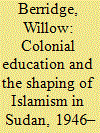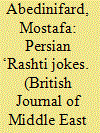|
|
|
Sort Order |
|
|
|
Items / Page
|
|
|
|
|
|
|
| Srl | Item |
| 1 |
ID:
168626


|
|
|
|
|
| Summary/Abstract |
This article assesses the role of British colonial education in Condominium Sudan in shaping the mindsets of Sudan’s first generation of Islamists between 1946 and 1956. Drawing on post-colonial theorists such as Nandy and Bhabha, it contends that the experiences of the pioneers of Sudan’s Islamic movement at institutions such as Gordon Memorial College and Hantoub Secondary School moulded their understandings of both ‘modernity’ and ‘tradition’. As a result of their colonial education, Islamists deployed discourses concerning both ‘progress’ and ‘cultural authenticity’ that bore remarkable parallels with colonial essentialism, even as they announced a decisive break with the colonial past. Much like the conventional nationalists, they used the space created by the colonial educational institutions to establish an ideological community that transcended the narrow ethnic and regional divides previously fostered by the British. At the same time, Islamists and colonialists alike shared a contempt for Marxists and ‘deculturated’ effendis, and Muslim Brothers’ aspirations to escape the ‘English jahiliyya’, however counter-intuitive this may seem, bore similarities with the worldviews of colonial officials concerned with preventing what they saw to be the excessive impact of urbanization and modern education on Sudan.
|
|
|
|
|
|
|
|
|
|
|
|
|
|
|
|
| 2 |
ID:
168623


|
|
|
|
|
| Summary/Abstract |
No fewer than 15 recent books repeat the claim that Ibn Saud’s militants killed or wounded 400,000–800,000 people during the Wahhabi conquest of the Arabian Peninsula between 1902 and 1925. In this paper, I uncover the origins of this disturbing statistic and challenge its validity. On the basis of primary-source data—especially the reports of British agents and observers working in the Arabian Peninsula at the time—I argue that the number of people killed and wounded during the Wahhabi conquests, while still great, has been wildly exaggerated, and I propose a more realistic casualty estimate.
|
|
|
|
|
|
|
|
|
|
|
|
|
|
|
|
| 3 |
ID:
168630


|
|
|
|
|
| Summary/Abstract |
The study of political leadership in Lebanon has most often revolved around the questions of the attributes and networks of leaders commonly considered within the frame of patron–client relations. In this empirical article, I propose to shift the focus towards the dynamics of identification at the centre of the nexus between leaders and followers. Focusing on the case of the recently elected president of the Republic, Michel Aoun, I draw on testimonies collected among his supporters to expose how his character instigates acts of affective memorialization. Voicing manifold social inspirations, both private and collective, these memory practices anchor the attachment to the leader into multiple temporalities and emphasize contrasts with alternate repulsive figures to perform social bonds and boundaries. The stories composed around this cast of characters illuminates the historical as well as emotional processes at the heart of political identification in Lebanon.
|
|
|
|
|
|
|
|
|
|
|
|
|
|
|
|
| 4 |
ID:
168628


|
|
|
|
|
| Summary/Abstract |
As Iraqi forces invaded the Iranian border shortly after the Islamic Revolution, the Islamic Revolutionary Guard Corps (IRGC) participated in the battle along with the debilitated Iranian Army. The IRGC was a young religious-revolutionary institution that lacked the resources that revolutionary armies and militias conventionally rely on. Nevertheless, it survived the battle pressure and even achieved relative military successes in the second year of the war. By examining personal narratives written by Iranian veterans, this article argues that in the void of conventional resources in the first year of the war, the Guards retrieved elements of their Shia background to recognize a religiously inspired charisma in every combatant who would devotedly step up for martyrdom. This shared understanding of the omnipotent charisma was then acknowledged in action—by commanders’ deployment of it to impose order and through frequently held Shia rituals on the battlefield. It thereby created an alternative source of cohesion and motivation that led to the IRGC’s survival and prepared them for further successful steps by the end of the war’s first year.
|
|
|
|
|
|
|
|
|
|
|
|
|
|
|
|
| 5 |
ID:
168627


|
|
|
|
|
| Summary/Abstract |
Israel’s highly restrictive citizenship policy constitutes the clearest indicator of its dominant ethnic model of citizenship. However, this policy has faced new challenges since the early 1990s, following the mass migration of non-Jewish immigrants. This paper examines and characterizes changes in immigrants’ entitlement to Israeli citizenship since the 1990s. It indicates that while Israel’s traditional citizenship policy has not undergone any significant change, two trends are evident: a much more restrictive policy towards Arab immigrants; and a somewhat more inclusive policy concerning other immigrants. To explain how these conflicting trends have coexisted, this study identifies three major characteristics of the Israeli policy: widespread use of the ‘divide and rule’ technique; managing policy through bureaucratic decisions; and the growing assimilation of liberal and republican principles into Israel’s citizenship policy, although without undermining—on the contrary, even reinforcing—the dominant ethnic model of citizenship. These findings indicate that although the dominant ethnic citizenship model in Israel remains stable, and can successfully tackle significant obstacles, limited opportunities exist for greater inclusion of specific non-Jewish populations within the Israeli polity.
|
|
|
|
|
|
|
|
|
|
|
|
|
|
|
|
| 6 |
ID:
168629


|
|
|
|
|
| Summary/Abstract |
The small Gulf state of Qatar is today home to as many Christians, and as many Hindus, as it is Qatari citizens, making it one of the most religiously diverse states in the Middle East. A somewhat unintended consequence of the developmental trajectory Qatar has embarked on, like other emergent social realities religious diversity poses a threat to the identity of both the state and the small citizen population, and must be managed. This article explores how the state is responding to the challenge of religious diversity by looking at ‘Church city’, a recently built complex that houses several Christian churches on the outskirts of Doha. I argue that efforts to manage religious diversity are informed by notions of protection and segregation, as can be identified both in Islamic historical precedents, and in the state’s broader response to its developmental dilemma.
|
|
|
|
|
|
|
|
|
|
|
|
|
|
|
|
| 7 |
ID:
168625


|
|
|
|
|
| Summary/Abstract |
For almost a century, a Persian ethnic joke cycle has circulated among Iranians about the men and women of the northern Iranian city of Rasht, labelling them as cuckolds and promiscuous women. A foray into the historical background and possible (gendered) functions of these jokes is long overdue. I argue that the central motif of Rashti jokes is gheyrat—a gendered social construct based on a man’s sense of honour, possessiveness and protectiveness towards certain female kin—which remains pivotal to our understanding of the texts and the historical context of the jokes. Critically reviewing extant theories on the historical origins of Rashti jokes, I argue they have roots in two modern phenomena: (a) debates among turn-of-the-twentieth-century Iranian thinkers over women’s (un)veiling; and (b) Reza Shah’s methodical promotion of an Aryanist, pan-Persian ideology. Focusing on the gender-disciplinary functions of the jokes, I then show how some contemporary Rashti jokes are deployed to project and inscribe gender-hierarchical notions that clearly surpass the jokes’ immediate, ethnic targets by commenting on broad socio-political topics. Such instances suggest that as a culture-wide joke cycle, Rashti jokes may also reinforce a form of Iranian masculinity obsessed with gheyrat-motivated control and aggression.
|
|
|
|
|
|
|
|
|
|
|
|
|
|
|
|
| 8 |
ID:
168624


|
|
|
|
|
| Summary/Abstract |
This article examines electoral competitiveness between the two main contenders in Morocco’s 2016 legislative elections, i.e. the Islamist Party of Justice and Development (P.J.D.) and the pro-monarchy Party of Authenticity and Modernity (P.A.M.). In contrast with electoral results at the national level, which reflect a high parliamentary competitiveness between these two parties, the analysis of competitiveness at the local constituency level (92 electoral districts) leads to quite different conclusions. The degree of local standard competitiveness between the P.J.D. and the P.A.M. was generally very low and, in most of the districts, the Islamists held a large advantage over the P.A.M. Other third parties also played a significant role and became the voters’ first or second choice in some districts, with the effect of increasing parliamentary fragmentation and decreasing competitiveness between the P.J.D. and the P.A.M. Thus, the proportional system used in a large number of districts contributed to achieving the monarchy’s aim of avoiding a predominant party. Also, the central role played by the loyalist National Rally of Independents (R.N.I.) in blocking the coalition government talks after the elections questions the idea that the Moroccan party system is becoming polarized between the P.J.D. and the P.A.M.
|
|
|
|
|
|
|
|
|
|
|
|
|
|
|
|
|
|
|
|
|